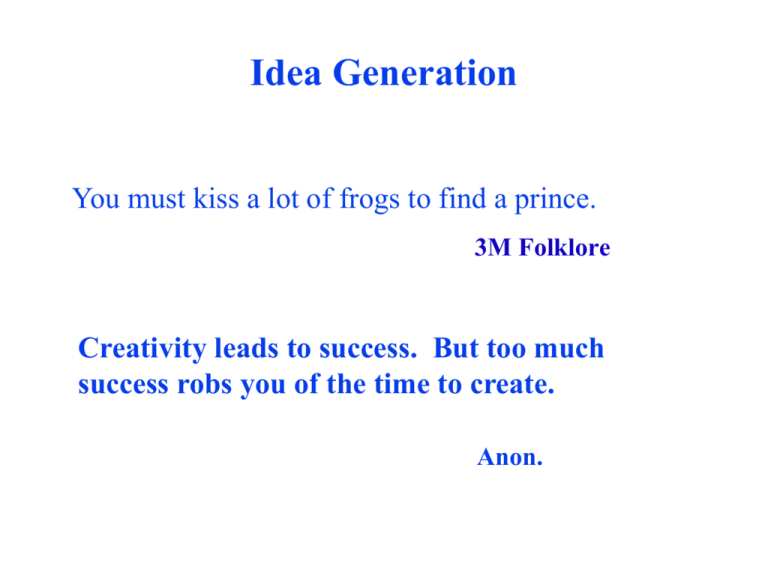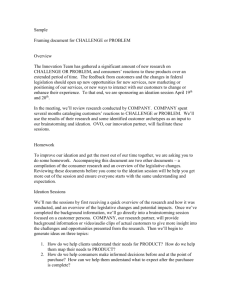NEW PRODUCT COURSET
advertisement

Idea Generation You must kiss a lot of frogs to find a prince. 3M Folklore Creativity leads to success. But too much success robs you of the time to create. Anon. Understanding Individual Creativity Barriers to creativity Past experience Quick judgment Fear of failure Poor problem definition Overcoming barriers to creativity More visualization Forced connections (lateral thinking or divergent thinking) Relaxation Creativity-aiding tools New Products–2 Ideas for TV Series 2,000 Ideas 100 Scripts 20 Pilots 5 Scheduled for prime time 1 Success New Products–3 Some Tools for Idea Generation Small’s Ideation Stimulator Mindlink - Synectics Process Idea Fisher - Forced connections New Products–4 Small’s Ideation Stimulator 1. Can the dimensions be changed? Larger Smaller Longer Shorter Thicker Thinner Deeper Shallower Stand vertically Place horizontally Make slanted or parallel Stratify Invert (reverse) Crosswise (bias, counter) Converge Encircle Intervene Delineate Border Economy-size packages, photo enlargements, puffed cereals U.S. paper market, hearing aids, tabloid newspapers, pocket flashlight, microfilm King-sized cigarettes, typewriter carriage for bookkeeping Men’s shorts, woman’s panties Rug pads, heavy edge on drinking glasses, glass bricks Nylon hose, seersucker suits, wristwatches Deeper pockets in work clothes and army uniforms, grooved battery plates Wading pools, children's drinking fountain Skyscrapers (to increase floor space on expensive land), upright piano Ranch-style homes (to avoid stair climbing) Reading stands, car mirror, eyeglass frames Plywood, storage pallets, layer cake Reversible coats, soft shoes to be worn on either foot, inverted ink and glue stands Bias brassieres and slips, pinking shears Mechanical artificial hands, ice tongs Spring cake form, knitted coasters to slip on bottoms of highball glasses, Life-Savers Buffers used in drug products to temper a harsh active ingredient Contour lathe, Scotchlite reflective sheeting Mats for pictures, movable office partitions, room separators Source: From Marvin Small, How to Make More Money (New York: Pocket Books, 1959). Copyright 1953, 1981, Marvin Small. Reprinted by permission of Pocket Books, a Simon & Schuster division of Gulf and Western Corporation. © New Products–5 Small’s Ideation Stimulator 2. Can the quantity be changed? More Less Change proportions Fractionate Join something Add something to it Combined with something Complete Extra-pants suits, three stockings (a pair with a spare) Variety of 1-ounce boxes of cereals, ginger ale splits Nested chairs or dishes, hot-cold water faucets Separate packing of crackers inside single box, 16-mm movie film usable as two 8mm films, faucet spray Trailer, hose couplings Cigarette filter tip Amphibious auto, outboard motors,roadable airplanes Freezer unit added to refrigerator, Bendix washer and dryer single unit 3. Can the order be changed? Arrangement Precedence Beginning Assembly or disassembly Focus Car steering wheels left handed in United States, right-handed in England, Deweydecimal system of filing Rear-drive automobiles Self-starter, red tab to open cigarette package, red string to open Band-Aids Prefabricated articles, knockdown boat kits Kellogg packages--Name placed in corner instead of center, Hathaway shirt ads--man with eye patch 4. Can the time element be changed? Faster Slower Longer Shorter Chronologized Perpetuated Synchronized Anticipated Renewed Recurrence Alternated Quick-drying ink, dictating machine, intercom system High-tenacity yarns for longer-life tires, 33 1/3-rpm long-playing records Jiffy insulated bags for ice cream, wood preservative Pressure cooker, one-minute x-ray machine Defrosting devices, radio clocks Photographs, metal plating, permanent magnets Uniform vacation periods, group travel tours Thermostat, freezer food-buying plan Self-charging battery, self -winding watches Switch clocks for lights and electrical appliances Cam drive, electric current New Product Management (Spring 1998), The Penn State University 6 Small’s Ideation Stimulator 5. Can the cause or effect be changed? Stimulated Energized Strengthened Louder Softer Altered Destroyed Influenced Counteracted Generator Magneto, power steering AC-DC transformer, Simonize car coating Volume control, acoustical aids Sound insulator, rubber heels Antifreeze chemicals, meat tenderizers Tree spraying, breath and perspiration deodorants Legislation to permit sale of colored oleo, wetting agent catalyst Circuit breaker, air-conditioning, filters 6. Can there be a change in character? Stronger Weaker Altered Converted Substituted Interchanged Stabilized Reversed Resilient Uniformity Cheaper More expensive Add color Change color Dirt-resistant paint Pepsi-Cola made less sweet, children’s aspirin Aged or blended whiskey, transit-mixed cement Convertiplanes (for vertical and horizontal flight) Low-calorie salad dressing (made without oils) Interchangeable parts, all-size socks Sperry gyroscope, waterproof plastic bandage Two-way locomotives Foam-rubber upholstery, cork floors Standards in foods, drugs, fuels, liquors Coach air travel, paper cups Cigarettes in cardboard or metal boxes, deluxe editions of books Color television, colored plastics Variously colored toothbrush handles, automobiles, electric light bulbs New Product Management (Spring 1998), The Penn State University 7 Small’s Ideation Stimulator 7. Can the form be changed? Animated Stilled Speeded Slowed Directed Deviated Attracted Repelled Admitted Barred Lifted Lowered Rotated Oscillated Agitated Moving staircases, package conveyors Air brakes Meat-slicing machine Shock absorbers, gravel driveway Flowermeters Traffic islands Magnetic devises Electrically charged fencing Turnstiles Gate, fence Forklift truck Ship locks Waring blender, boring machines Electric fan Electric scalp stimulator 8. Can the use be adapted? Men Women Children Old Handicapped Foreign Colognes, lotions Colored-tip cigarettes Junior-size tools, cowboy clothes Walking stick chairs Chair lifts Reader’s Digest foreign editions New Product Management (Spring 1998), The Penn State University 8 Small’s Ideation Stimulator 9. Can the state or conditions be changed? Hotter Colder Harden Soften Open or closed Preformed Disposable Incorporated Parted Solidified Liquefied Vaporized Pulverized Abraded Lubricated Wetter Drier Insulated Effervesced Coagulated Elasticized Resistant Lighter Heavier Electric hot plates, washed coal Freezer, thermos jug, water cooler Bouillon cubes, cream shampoo (instead of liquid) Krilium soil conditioner, water softeners Visible record equipment, electronically operated doors Prefabricated housing, prepared Tom Collins mixer Bottle caps, Chux disposable diapers, Kleenex tissues Counting register on printing press, cash registers Caterpillar tractors, split-level highways Bakelite and other plastics, citrus concentrates Chemical plant foods Nasal medical vaporizers Powdered eggs, lawn mower attachments to powder leaves, Disposal garbage pulverizer Snow tires or chains Self-lubricating equipment Hydraulic brakes De-Moist for cellars, tobacco curing Fiberglass, Dr. Scholl’s foot appliances (insulate feet against pressures) Alka-Seltzer Jell-O and Junket desserts Latex girdles, bubble gum, belts Rubber footwear Aluminum luggage, automatic electric blanket Can opener with weighted stand New Product Management (Spring 1998), The Penn State University 9 New Product Forecasting We have two classes of forecasters: Those who don’t know and those who don’t know that they don’t know. - John Kenneth Galbraith Methods for Forecasting New Product Sales Early stages of development Chain ratio method Judgmental methods Scenario Analysis Diffusion modeling Later stages of development Pre-test market methods Test-market methods New Products–11 Advantages of Chain Ratio Method Helps forecaster use more information Helps distribute errors Can partition problem to different members of a project team Can obtain expert help on specific parts Can apply different methodologies to different parts New Products–12 The Bass Diffusion Model Model designed to answer the question: When will customers adopt a new product or technology? New Products–13 Assumptions of the Basic Bass Model Diffusion process is binary (consumer either adopts, or waits to adopt) Constant maximum potential number of buyers (N) Eventually, all N will buy the product No repeat purchase, or replacement purchase The impact of the word-of-mouth is independent of adoption time Innovation is considered independent of substitutes The marketing strategies supporting the innovation are not explicitly included New Products–14 Adoption Probability over Time (a) 1.0 Cumulative Probability of Adoption up to Time t Introduction of product F(t) Time (t) (b) f(t) = d(F(t)) dt Density Function: Likelihood of Adoption at Time t Time (t) New Products–15 Number of Cellular Subscribers 9,000,000 5,000,000 1,000,000 1983 1 2 3 4 5 6 7 8 9 Years Since Introduction Source: Cellular Telecommunication Industry Association New Products–16 Sales Growth Model for Durables (The Bass Diffusion Model) St = p Remaining + q Adopters Potential Remaining Potential Innovation Effect Imitation Effect where: St = sales at time t p = “coefficient of innovation” q = “coefficient of imitation” # Adopters = S0 + S1 + • • • + St–1 Remaining Potential = Total Potential – # Adopters New Products–17 Basic Elements of Scenario Analysis Structure a scenario as a flowing narrative, not as a set of numerical parameters. Include verbal descriptions such as “rapid experience effects,” “FCC adoption of digital standard,” etc. Ideally, each scenario should also include how the situation described in the scenario will be reached from the present position. Construct several scenarios that are approximately equally likely (Might also include scenarios that are most likely to happen, and least likely to happen). Describe all scenarios in the same manner, i.e., one is not more “vivid” than another. Develop forecasts and strategies that are compatible with the scenarios: Robust approaches that are resilient across scenarios (e.g., hedging, concurrent pursuit of multiple options, etc.) Contingent approaches that postpone major commitments to the future. New Products–18 Example Scenario National or international standards on analog HDTV are adopted and HDTV gets a buy-in by all stakeholders. The implementation proceeds quickly. Production studios start producing TV programs in the new format, and cable and broadcast TV stations start a rapid upgrade of their equipment to HDTV format. HDTV sets are retailing at prices comparable to that of standard TVs of equivalent screen size. The market penetration starts ramping up almost immediately. New Products–19 Another Scenario A digital HDTV standard is adopted. HDTV sets employ new technology: they are costly and somewhat unreliable. It takes a few years to iron out the problems and for the industry to walk up the learning curve. Early adopters amongst consumers are frustrated and unhappy, they comment: “This technology just does not work”. TV stations drag their feet on upgrades because: “This costly change comes straight off our bottom line for no additional benefit to us. We will not get any additional advertising revenue or higher subscription rates from digital HDTV.” The penetration starts ramping up only after at least 8 years of lackluster sales. New Products–20 Parameters of the Bass Model in Several Product Categories Product/ Technology B&W TV Color TV Air conditioners Clothes dryers Water softeners Record players Cellular telephones Steam irons Motels McDonalds fast food Hybrid corn Electric blankets Innovation parameter (p) Imitation parameter (q) 0.028 0.005 0.010 0.017 0.018 0.025 0.004 0.029 0.007 0.018 0.039 0.006 0.25 0.84 0.42 0.36 0.30 0.65 1.76 0.33 0.36 0.54 1.01 0.24 A study by Sultan, Farley, and Lehmann in 1990 suggests an average value of 0.03 for p and an average value of 0.38 for q. New Products–21 Factors Affecting the Rate of Diffusion Product-related High relative advantage over existing products High degree of compatibility with existing approaches Low complexity Can be tried on a limited basis Benefits are observable Market-related Type of innovation adoption decision (eg, does it involve switching from familiar way of doing things?) Communication channels used Nature of “links” among market participants Nature and effect of promotional efforts New Products–22 Some Extensions to the Basic Bass Model Varying market potential As a function of product price, reduction in uncertainty in product performance, and growth in population, and increases in retail outlets. Incorporation of marketing variables Coefficient of innovation (p) as a function of advertising p(t) = a + b ln A(t). Effects of price and detailing. Incorporating repeat purchases Multi-stage diffusion process Awareness Interest Adoption Word of mouth New Products–23




